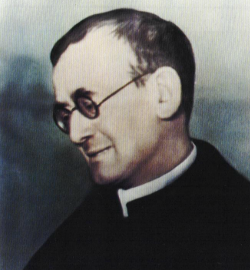
The day Saint Justin was born, an unusual and abundant snowfall occurred in Pianura, an area where snow very rarely appears. That same day, his parents brought the infant through the snow to their Church for Baptism. Justin was the third of six boys and girls. From this beautiful nest, the Lord picked three for himself: Justin became a priest and the founder of the Society of Divine Vocations; Ciro entered the same congregation later and became a priest as well; and Giovanna joined their female branch, eventually becoming its Superior General.
In addition to his parents who included in him the basic principles of the Christian life, Justin remembered with deep gratitude the part played in his vocation by his three aunts, all schoolteachers.
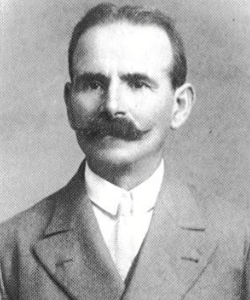
Upon completion of his elementary school, a genuine problem arose. From early on, young Justin had said to everyone that he wanted to be a priest. He strengthened his wish through prayer and the reception of the sacraments. To satisfy his desire, it was necessary to provide a Seminary with the means to pay for tuition. His family was quite large, and the means at their disposal were limited. His parents tried to approach a wealthy man in Pianura and seek his help. When they were turned down, his mother, in a mixture of anger and faith told her son: “Don’t be afraid, Justin, your mother will send you to the seminary even if she has to pawn her eyeballs.”
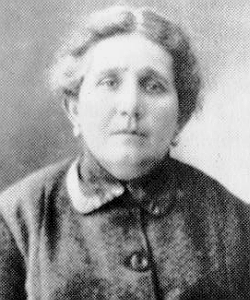
Sustained by this faith and determination, Justin was sent to Pozzuoli’s diocesan seminary. During the entrance examination, one of the teachers said: “I have never come across a young man as intelligent as this one.” He was admitted to the first year of high school.
Yet his beautiful and promising vocation was threatened in time by some adverse events. At first, his father was severely injured while working and, subsequently, one of his aunts – who was paying for part of Justin’s tuition – suddenly died. At this point, it was impossible for Giuseppina to keep her son in the seminary. However, before taking any painful decision, she decided to go to Bishop Giuseppe Zezza who, after hearing her story, immediately offered his help.
Justin continued his studies in the seminary. There he finished high school, college, a year of Philosophy, and the first two years of Theology. As a result of the updating of the seminary curriculum decreed by Pius X, Justin was sent to the newly built Regional Seminary of Posillipo, which was staffed by the Jesuit Fathers. Since the new accommodations were not all ready for occupation, Justin was given a room in the religious house of the Jesuit priests, which was attached to the new seminary.
Justin’s intelligence, goodness, humility, and spirit of prayer were irresistible and contagious. One priest who lived in the same house, Monsignor Nicola Esposito, said, “That little room where Justin lived remained lit up long into the night. We used to peek through the keyhole and see him on his knees praying before a crucifix. It was my distinct impression and that of my peers and superiors that we were in the presence of an angel.”
The Jesuits, especially Fathers Antonio Stravino, Giuseppe De Giovanni, and Giuseppe Manzo, very often spoke with enthusiasm about this new seminarian and referred to him as the most intelligent and holy seminarian who ever passed through their theological institute. Father Stravino once said in particular, “Justin is a saint who should be canonized during his life; the Church should make an exception for him.” His remarks became much more significant when we learned from other sources that Father Stravino was extremely moderate in his praises.
On September 20, 1913, Justin was ordained a priest. The reception in his town was a warm and joyous one. It was marked by two coincidental occurrences that increased even further the happiness of everyone in town. Abundant rain fell after many months of drought, and the new aqueduct that brought the city water to the whole area of Pianura was finally opened. People from all walks of life were exceptionally joyful that day. At a certain point, someone from the crowd welcoming the new priest exclaimed: “We want him to be our Pastor!“ Immediately, everyone joined in that thunderous popular outcry.
Father Justin, however, was not to become their pastor as easily as people wished. The bishop of Pozzuoli, the Most Reverend Zezza, called Father Justin to the seminary and put him in charge of the formation of the new seminarians. As soon as he began his first mission, a sizable group of young men started visiting him in Pozzuoli from Pianura every week, covering the distance of six miles between the two on foot. What was happening? From his first years as a seminarian, Father Justin had shown his strong inclination to the apostolate among the incredibly young, exercising a powerful influence over them. In his biography of Saint Justin, A PRIEST OF YESTERDAY, Fr. O. Anella says, “The daily catechism taught to young people was the first and greatest Apostolate that the servant of God, Father Justin, began in his native town every time he returned there for his vacation. His arrival in town was always a great occasion for celebration on the part of the little ones who met him with joy and gathered around him in the garden of his father’s house. Together with the catechism, he would teach them songs, games, and the Bible, and would read with artful skill the lives of the saints. At times, more than two hundred visited, all singing songs that he himself had composed or adapted.”
Fr. Justin’s intention was to fulfill two objectives: first, to guide the children of his town in the knowledge of our religion, and second, to identify among them the ones who showed signs of a call to the priesthood or religious life. With his keen intuition, he would pick them out, separate them from others and instruct them with special attention, as Jesus had done with his twelve Apostles. Once he had discerned in them the sure signs of the divine call, he would start displaying before their eyes the beauty of consecrated life.
He called this exclusive group “Faithful One.” These were the young boys who started going to Pozzuoli to visit Father Justin. They couldn’t live without him; they needed him. They needed the “Bread” that their spiritual Father had made them taste. Those visits to Father Justin were moving proof of their endurance, and Father Justin himself was touched by their affection. With them, Father Justin prayed often and dreamed of a future religious life. He prayed, fasted, made penance, and begged the Lord to show him the way.
His prayer and mortifications were heard from above. After a few months of directing the discipline and growth of the seminarians in Pozzuoli, Bishop Zezza became aware of Father Justin’s poor health and decided to send him back to Pianura.
The “Faithful One” was overwhelmed with joy. Father Justin then proceeded to organize them according to his ideals. On April 30, 1914, he made the first attempt at common life, in his father’s house. Everything was taking place with the consent and understanding of the members of his family and “Papa” Luigi even offered to extend Justin’s apartment. It was decided also that Aunt Michelina would take care of the kitchen and Father Justin, donning an apron, volunteered to wait on the table. At night, the boys would go to sleep, and he would mend their socks and pants, getting everything ready for the following day. It was something new. Everyone was apprehensive about the future and wondered what was lurking around the corner.
The idyllic experience lasted only fifteen days. Bishop Zezza had gone to Soccavo, a little village near Pianura, for a pastoral visit. He sent for Father Justin and directly told him that he had heard about the experiment at common life, and he did not like it. The new experience, he said, was to be discontinued immediately.
This order came like a shock to the servant of God. He accepted the order with resignation and told the bishop that he was ready to obey. Father Justin’s idea was God’s work and as such, it had to be tried and put through the crucible.
That day, while still in Soccavo, he decided to visit some members of his family who were living there. He tried to open his soul and share his grief with his Aunt Scherillo. Instead of comforting him, she gave him as a present a cross made of hardwood. The gift was to be a symbolic one.
When he returned to his house in Pianura, he ate with his usual serenity and joviality. At the end of the meal, he took out the cross he had received as a gift. With calm and resignation, he said, “We are all children of the Cross. Let us submit our will to our superiors and be like Jesus who sacrificed His will to His Father’s wishes.” He disbanded the “Faithful Ones” as a community but continued getting together with them in the garden of his father’s house where the formation work went on informally.
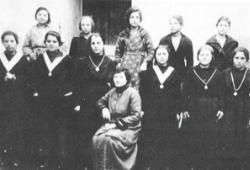
This picture shows the new group of souls that later would inspire Father Justin to establish the female branch of the Congregation. Twelve girls quickly spread throughout the parish and became like the good yeast among their peers.
As a result of the order received from the Bishop, Father Justin continued to work among the young with prudence and always under the direction of the local pastor. He felt compelled to address his plea for a new congregation to Rome. In July 1915, in fact, he wrote to the Sacred Congregation for Religious, but he never received an answer. Then his spiritual director advised him to write directly to Cardinal Pietro Gasparri, Secretary of State of his Holiness, and reveal to him his “plan” to establish a new religious family for the gratuitous care of vocations. The news about his letter went around the diocese. One day the Vicar General of the diocese told Father Justin: “Justin, is it true that you wrote to Rome?” The Vicar continued: “Do you have extraordinary signs?” Father Justin replied, “No,” then added, “but I have all the ordinary ones.” The Vicar General concluded: “Well. If our bishop is transferred from here, it will certainly be an extraordinary sign for all of us.” An extraordinary sign was to come. Bishop Zezza later was transferred to Naples. Before he left, he began showing some interest in Father Justin’s plan and had encouraging words for him.
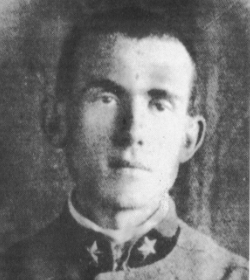
The First World War was already raging all over Europe. In 1915, Italy entered the conflict. As a result, Father Justin was called into service although in the medical inspection he had undergone at the age of twenty, he was declared temporarily unfit. Soon after had been dismissed as permanently unfit. However, now that war had broken out, he was called again for a review of fitness. The head of the committee who reviewed his physical condition was ferociously anti-clerical; although Father Justin appeared very frail and weak, he declared him fit for service. The day Father Justin left for the front, a captain looked at him and felt so sorry for the man who was succumbing under the weight of his backpack that he asked a young boy to help him fasten it. For two years Father Justin dragged himself among the soldiers and tried to assist as many as possible as a paramedic.
Meanwhile, his health did not improve. One day a medical officer felt so moved by this “walking skeleton” that he decided to send him home with a recommendation for permanent discharge. Father Justin went home, but the final discharge never came. His family then decided to address their plea to Queen Helen and beg her to intervene on behalf of Father Justin. He was called for an additional review of his fitness. This time his condition was recognized, and a final discharge was quickly granted.
His military duties had not discontinued the communication between him and his young groups in Pianura. Both from the barracks and front line, he continued reaching them with circular letters that his boys at home devoured.
One day during his military service, he met the sisters of Saint Bartholomeo Capitanio in Mestre (Venice) and, observing the tremendous work they carried on in the hospitals, he was confirmed in the idea of a female branch of his Congregation and in his plan of enlisting his sister Giovanna’s help in this new endeavor.
Now that he was free of military service, he would have liked to dedicate himself to the building of his two congregations, but he felt paralyzed by the order that he had received from the Bishop of Pozzuoli. To break the manacles that had been snapped around his vocation plan, he decided to appeal to the Bishop of Troia (Foggia), the Most Reverend Fortunato Farina, and ask permission to establish in his Diocese a Congregation for Vocations. Bishop Farina, on July 8, 1920, offered Father Justin the administration of the seminary and a convent for his Religious, who would be allowed to attend the school at the diocesan seminary.
Bishop Pasquale Ragosta, Bishop of Ischia, and Apostolic Administrator of Pozzuoli, invited Father Justin to enter the canonical process for the pastorship of the parish of St. George Martyr in Pianura, which had suddenly become vacant. The servant of God, with much clarity and humility, told the Most Rev. Bishop Ragosta both of his intention of founding a Congregation exclusively for vocations, and of the difficulty he had encountered with Bishop Zezza, former Bishop of Pozzuoli. He concluded that if he would enter the canonical procedure for the pastorship of the Parish of St. George Martyr. However, if there were any difficulty in obtaining such permission, there would be no alternative but to accept the invitation from the Bishop of Troia to join his Diocese and do over there the work God had called him to do in Pianura.
Bishop Ragosta acceded to his request and Father Justin entered the pastorship process. On September 20, 1920, he officially became the pastor of his hometown.
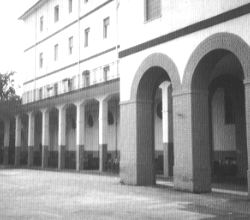
On October 18, 1920, in the Rectory of St. George Martyr, with the blessing of Bishop Ragosta, the Society opened its door to all those young men who wished to dedicate their lives to the service of vocations.
It was the beginning of the Society of the Divine Vocations. As the number of candidates who flocked to Father Justin started to grow, the necessity of establishing a Mother House became compelling. Bishop Ragosta gave permission to acquire a building site, and the construction of a Vocationary, with the help of generous benefactors, soon became a reality. This was the first Vocationary which was named “Deus Charitas” (God is love).
For complete development of the Congregation, Father Justin designed a female branch of the Congregation – “The Sisters of the Divine Vocations – Vocationist Sisters.” With the authorization of the same Bishop Pasquale Ragosta on October 1, 1921, in an apartment at Villa Caleo Corso D’Aosta, in Pianura Naples, Father Justin invited a large group of young girls that he had previously formed spiritually and organized under the name of “Pious Union” and with them planned and established the Society of Divine Vocations for women.
God’s work was spreading extremely fast, and the Holy Spirit was filling the sails of the ship. On May 26, 1927, the Society of Divine Vocations for Men received the first Diocesan decree of approval from the new Bishop of Pozzuoli, the Most Reverend Giuseppe Petrone. It was followed by the approval of the sisters. This divine blessing caused many Bishops to invite the Servant of God to work in their Dioceses. After a few years, the center and south of Italy were dotted with his religious houses, both for men and women. 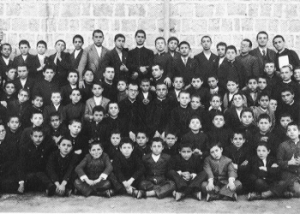
The work that Father Justin had begun was spreading throughout Italy, and both congregations were becoming highly active and efficient in their catechetical work in parishes and in their service to vocations to priesthood and religious life. It seemed that the future would be very promising as the sailing for the little boat of the Society of Divine Vocations was smooth, yet menacing clouds suddenly began gathering and threatening the very existence of the Society. Rumors about the poor maintenance and support of the young boys in the Vocationary and about the alleged irregularity of studies of the Vocationist candidates started affecting the work that had been painfully started. At a certain point, even the approval of the Congregation on a Diocesan level was called into question, because said approval had been issued without previous consent from Rome. When Father Justin realized that his Congregation was in danger, he decided to try extending his work and ideals to more dioceses. He requested Cardinal Ascalesi, of Naples, permission to open in his Archdiocese a House of Studies both for philosophy and theology students. His request was granted with a request from the Cardinal that he also try to contact other Dioceses. Father Justin willingly accepted that charge and was pleasantly surprised to be informed by Bishop Cammarota of Capaccio Valla, Bishop Cuccarollo of Bovino, and Bishop dell’Isola of Cava Dei Tirreni that they were willing to accept the help of Father Justin’s religious members with open arms in their Dioceses. Meanwhile, the accusations against the Congregation continued and found their way to Rome. This caused much distress to Father Justin, and partially paralyzed the work of the Vocationist.
Bishop Petrone of Pozzuoli made every effort to answer these accusations, rectifying or denying the accusations point by point. He firmly stated that the performance of the Vocationary in Pianura was excellent. In his report, he spoke highly of the “goodness and docility of Pastor Russolillo” and added that he had received in his seminary many good young men who had originally been in the Vocationary. Bishop Petrone concluded his report by stating: “The good Pastor Russolillo is well known for his honesty, piety and uncommon zeal”. The undaunted support of Bishop Petrone worked wonders. In fact, on June 2, 1931, the Diocesan decree of approval that had previously been questioned as to its validity, was officially endorsed by the Vatican. This new step was hailed with renewed hope and some fears and as well by both Congregations. In fact, everyone realized that the new action taken by Rome had brought both Congregations under the direct scrutiny of the Vatican. Bishop Petrone, on January 18, 1933, encouraged by the latest news and heeding a plea from Father Justin, decided to make a formal application to Rome for the final decree of approval of the Society in these terms, “The Society of Divine Vocations would like to see its effort crowned by a pontifical approval (…) It is my firm conviction that the Vocationist Congregation (…) will bring the Church many blessings as it has already done to my own Diocese and many other Dioceses which have accepted in their Seminaries hundreds of young men had been originally educated in the Vocationary.”
At this point, Father Oreste Anella in his biography of Father Justin, A PRIEST OF YESTERDAY, with a tinge of irony writes: “Father Justin was only guilty of taking article 1353 of the Canon Law too literally.” The canon says: “All priests, but especially pastors, will try to remove from the allurement of the world all those young men who show signs of a vocation to the priesthood and shall teach them piety and knowledge while cultivating in them the seed of vocation.”
The Vocationist Fathers were all waiting for approval from the Congregation for Religious because they believed the petition of Bishop Petrone could not remain unanswered. The Lord, however, had decided otherwise. To purify the two Congregations and establish them on the more unshakable ground, special visitors were to be appointed by the Vatican. It was their task to put the Congregations in a crucible and hammer out the final image that it would finally present to the Church and to the world. In fact, Bishop Castaldo who, in the meantime, had replaced Bishop Petrone in the Diocese of Pozzuoli on August 3, 1934, received word from the congregation for Religious that the petition of Bishop Petrone on behalf of the Society of Divine Vocations had been denied. In addition, to make things even worse, Bishop Castaldo confirmed some vague accusations launched against the Congregation by some elements that had been expelled from the Society. As a result of all this, dispositions came from Rome that was so restrictive that the existence of the Vocationist Society was threatened. Father Justin, in answer to this attack, wrote a “Memorandum” to Rome in defense of his Congregation and entrusted it to Bishop Castaldo with a request to forward it to the Congregation for Religious.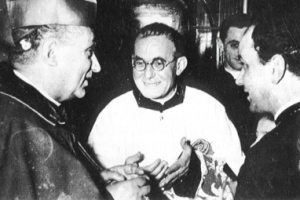
Father Domenico Mondrone, S.J., in a profile of Father Justin thus comments on this incident in Father Justin’s life: “Evidently, the bearer that Father Justin had chosen with so much faith and with so much promise of submission to the orders of the superior, in all honesty, was not the best one”. However, Bishop Castaldo still was the Ordinary of the Diocese and had to be obeyed. For a long time, a large volume of correspondence between Rome and Pianura via Pozzuoli went on. Then, despite a series of remedies administered and changes effected by Father Justin in his Congregation, Rome with a decree of July 21, 1941, sent an Apostolic visitor to the Vocationist Fathers in the person of Father Raffaele M. Baldini of the Servants of Mary. This was the first stage of a “Via Crucis” that submitted Father Justin to painful experiences which in the end revealed the evidence of his holiness and the strength of his faith in the work that he had begun. The Apostolic Visitor, Fr. Raffaele M. Baldini was a gentleman and a religious with profound faith and refined spirituality. When he first met Father Justin, he immediately detected his holiness and good intentions. He became his ally and friend.
The first thing that he reported to the Congregation for Religious was the opposing viewpoints existing between Bishop Castaldo and Father Justin. In a letter written to the Congregation for Religious, he said: “The Bishop of Pozzuoli in his fixed idea that the Vocationists are not to be religious cannot objectively evaluate those little defects that are very common among religious.” Then he concluded, “This way of thinking of the bishop certainly does not contribute to a dispassionate evaluation of the Society.”
Later, Father Baldini said: “It is my opinion, I confess, that the way the bishop views the Congregation has not helped my work.” In another report, Father Baldini pointed out that “as for the accusations that had been leveled against them, they were caused by some of their bad Oblates and by anonymous letters addressed both to the bishop, to the sacred Congregation for Religious and to the Pope himself. It is to be noted,” he concluded, “that some of these letters have been sent by someone who had been recommended to the care of the Vocationists by the Archbishop of Naples.”
Father Baldini did not hide the defects and gaps existing in the Society, yet he emphasized a lot of good in the Congregation and expressed no doubt about the hopes for the Congregation in the future.
Meanwhile, he noticed that in Rome “A Plan to remove the Servant of God, Father Justin, from the government of his Congregation was afoot and gaining momentum.” On September 22, 1944, he wrote to Rome expressing his strong opposition to such a plan. The following month, when Father Justin found out about the plan of action being nurtured in Rome, he wrote to Father Baldini: “Father, if you think that I am an impediment to the well-being of my Congregation, please put me aside in any corner; I will deem it a special blessing as long as I remain a religious and serve the Lord God in this Congregation. Where and how I live do not matter.” This letter convinced Father Baldini even more that Father Justin “was the only person who could govern the Society of Divine Vocations.” Knowing that the one who was sponsoring this movement was Monsignor Pasetto, under-secretary of the Congregation for Religious, Fr. Baldini wrote to him, … “It does not seem opportune, rather it seems very dangerous to me to remove the pious founder from the direction of his Society.”
Unfortunately, this firm and impassioned appeal from Father Baldini remained unanswered. Monsignor Pasetto, who by now had become the Secretary of the Sacred Congregation for Religious, on April 23, 1945, deemed it prudent to have Father Serafino Cuomo, a Franciscan, appointed Superior General of the Vocationists both for the male and female branch of the Congregation.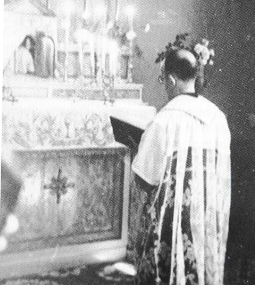
Father Baldini, who in the meantime had learned to love the Vocationists, felt very deeply wounded by these harsh measures and in saying goodbye to Father Justin thus wrote to him: “It is with deep regret my dear and Reverend Father that I part from you. Please, forgive me if I have not succeeded in doing my work better and for being unsuccessful in dispelling another trial. I have done what I could; I cannot do anything any longer. As of now, I have not received the official communication yet from the Vatican about my dismissal and this seems very strange to me; I am sure, however, that this measure has already been taken. Let’s raise our minds, my dear Father Justin, to supernatural thoughts and reflection, and let’s offer to God our respective mortification for the good of our soul and the salvation of your religious family.”
At this point, the unwelcome news spread and reached all the friends of the Vocationist Fathers. Father Mazzei, Spiritual Director of Father Justin, deeply affected by the sad events that were taking place in the Vocationist Society, decided to write to Pius XII and, among other things, said, “Most Holy Father, the Institute of the Vocationists is a new one and is making its way into the Church through the assiduous and loving work of its Founder. He has a great soul favored by God and guided by Him in his foundation work… His presence is necessary among his religious so they may mature, and their religious family may develop in full… Most Holy Father I put this petition of mine in your hands…forgive me if I dare to ask your Holiness to leave Father Justin, a man of God, in his place and leave at the same time as Apostolic visitor, Father Baldini, who for many years has helped the growth of the Vocationist family”. Fr. Mazzei wrote to no avail.
Father Justin was removed as Father Cuomo replaced Superior General and Father Baldini. In the meanwhile, a very unpleasant incident had taken place to make things even worse. During the Second World War, when Father Justin and his Congregation were kept separated from Rome for a long time, a certain layman, Mr. Omnis who had been dismissed by the Vocationists and had been granted only temporary hospitality in their religious house of Anagni, succeeded with false documentation, in being ordained sub-deacon by the local Bishop. As soon as military operation permitted, Father Giorgio Saggiomo, Vicar General of the Vocationist Fathers, traveled to Rome with a stop in Anagni. There, once acquainted with Omnis’ fraudulent ordination, he informed Father Baldini who still was the Apostolic Visitor, to mitigate the adverse impact of that regrettable event.
It was too late. The news reached Rome immediately and wrought havoc in the Congregation. This incident certainly contributed to the confirmation of the original plan of appointing Father Cuomo as Superior General of the Fathers and Sisters.
Father Cuomo started governing the Congregation with preconceived ideas. Father Mazzei, Father Justin’s spiritual director, in a letter to Pius XII, thus described the situation that had soon materialized between Father Justin and the new Apostolic Visitor and Superior General: (The Apostolic visitor) “(…) tries to separate his religious from their Father (…) he would like to remove Father Justin from Pianura but he is unable to do so only because he is a pastor there(…) shortly, Father Cuomo will come to Rome and report to you about this matter.”
How did Father Justin react to the storm that had enveloped him and the Religious Society? A letter that he wrote to his sister, Giovanna, who also had been deposed as a Superior General of the Vocationist Sisters, best describes his humble acceptance of God’s will. In this letter, he indicates the main spiritual advantages that might be derived from the measures taken against him and his Congregation, “If we think of these measures as human instruments we may suffer; yet, if we look at the Divine Mind that uses them for our own good, we shall rejoice. The real reasons for these measures are not those in the heads of people who caused them or imposed them. The real reasons are to be found in God (…) and they are a mystery of predilection for our persons and our congregations. With these measures, according to the world, we fall but according to the Lord, we really rise. With this purification, we receive a very sure sign that the Lord wants to admit us to His Divine Union and partake in the holiness of the Saints. This is the real gift that the Divine Trinity has entrusted to us and only in Heaven we will understand its incomparable value”. Then he concluded: “Let’s ask the Lord to grant us, through all these events, the blessedness of the Beatitudes and the enjoyment of all the fruits of the Holy Spirit.”
As was to be expected, the change in the government of the Congregation and the privation of the daily spiritual sustenance of the religious from the founder, caused dispersion and disorientation. Father Justin became very worried and decided to write to the Apostolic Visitor and Superior General about this painful situation, which was putting the Congregation in danger.
Father Cuomo, who by now had started changing his mind about Father Justin, listened to him after a long reflection and came to the decision of returning the spiritual direction of both Congregations to Father Justin. Father Cuomo understood that the Congregation did not reflect the description presented to him by the secretary of the Congregation for Religious and realized that Father Justin was not the disobedient priest that some people had described. Moreover, Father Cuomo slowly observed that this new opinion about Father Justin was being strengthened and shared by many Bishops.
However, the incomprehension, slander, and malicious gossip that had accumulated against Father Justin and his work were just too many to disappear as if by magic. The agony had to go on for many more years and Father Justin had to remain in the crucible so that his virtues one day could shine brightly.
It seems almost unbelievable that while he was being mistreated and misunderstood, in writing to his superiors, he would state, “I am very sorry for being the involuntary cause of displeasure to my ecclesiastical superiors and for exposing my Congregation to destruction.” This kind of humility could not remain without reward. Father Cuomo remained as Superior General of both Congregations for fifteen months. During this time, many transfers were affected, new houses were founded, and many situations and wounds were healed. Before the Visitor completed his job, he planned to have an election in the Congregation and to exclude Father Justin as a candidate for Superior General. This election never took place and, upon Father Cuomo’s departure from the Congregation, the Holy Seed deemed it prudent to appoint the Vicar General, Father Giorgio Saggiomo, as acting Superior General of the Fathers. He remained in this position for six months only. At the end of this period Cardinal Lavitrano, the new Perfect of the Congregation for Religious presided over the Chapter of the Vocationist Fathers and announced the election of Father Justin as Superior General of the Congregation. It was April 10, 1947. That date will never be forgotten by the Vocationists and all their friends.
The Vocationist Congregation of the Sisters and Fathers became Congregations of Pontifical Rights respectively on January 3 and May 24, 1948.
Father Justin began thinking of sending his Religious overseas. In April of 1950, at the request of the Cardinal of Bahia, Brazil, a little group of Religious headed by Father Ugo Fraraccio crossed the ocean. They established the first Vocationist mission in that land. In November of the same year, eight theology students and a vocationist priest headed for Salvador, Bahia, to join the other Religious.
Now, the Congregation had to ascend just one final step and obtain the Decretum Laudis. To facilitate this work, the Vocationists requested the Holy See to appoint an Assistant. It was granted in the person of the Jesuit Father Giuseppe Manzo. When the sailing was smooth and everything seemed to prosper and grow with the acquisition of a house on Via Cortina d’ Ampezzo, Rome, a new and unforeseen storm beset the Congregation and threatened to shake its very foundations. A dreadful financial crisis had developed, and the Congregation found itself engulfed in and almost drowned by debts.
This painful situation had been caused by some administrative mistakes made by the Treasurer General, Father Giorgio Saggiomo, who was a saintly man but certainly not an expert in finances. It was the last odyssey Father Justin had to face. He suffered under the weight of debts for many years. During this time, he prayed in humility and resignation. Finally, a loan from Pope Pius XII and the sale of some properties of the Congregation provided the light at the end of the tunnel. The Congregation could finally breathe again. Unfortunately, Father Justin did not see his dream materialize. His health was quickly deteriorating. His body had been submitted to penance and had endured numerous sicknesses. His mind had been disturbed by fear of a financial debacle. The end was near. On July 21, 1955, he wrote to Father Oreste Anella that he wished to leave for the Cilento region to recuperate. He left but returned immediately.
He went to bed never to rise again. On August 2, 1955, surrounded by his Religious, he returned his soul to the Lord. He was only sixty-four, not an old man, but he was ready for Heaven. On the day of his ordination, he had offered his life for the success of the Society of Divine Vocations. God had granted his wish and accepted his offer. When he died, the Congregation of the Vocationist Fathers had one hundred and ten priests and seventy professed members, twenty novices, and five hundred aspirants. The Vocationist Sisters numbered three hundred and forty professed members, thirty novices, thirteen postulates, and two hundred aspirants.
During his life simple people, religious, bishops, and cardinals seemed to detect in his personality something supernatural and felt attracted by his pious manners. Everyone in the area where Father Justin lived wanted to see and talk to him and receive a word of encouragement.
Parishioners, priests, politicians, professionals, and prodigal sons, each day formed a lengthy line to say goodbye to Father Justin. He had welcomed everyone with a smile that opened hearts and minds to faith and hope. In his spiritual life, his fixed goal was Divine Union with God. This was the ascetical program that he practiced. This was the aim that he inculcated in every soul and to its achievement he dedicated his whole life.
Father Louis Caputo in the first English biography of Father Justin, A SERVANT OF THE DIVINE VOCATIONS, remarks: “His ministry consisted mostly in preaching, teaching and administering the sacraments. He never tired of giving lectures and retreats to priests and sisters (…) he believed in universal sanctification and indicated spiritual direction as the most effective means of leading people up the ladder of Christian perfection.” The transcendent world was his passion, and the following spiritual writings all talk about its beauty: “Spiritus Orations, “Offertories of the Most Precious Blood,” “Ascension,” “Heaven of Heavens,” “The Piety of the Seminary,” “Evangelization of the Divine Union,” “I am the vine, and you are the branches,” “Remain in my love,” etc. They are hymns of praise and love to the Lord of the Universe. However, we should not believe that he was a man who only lived in the world of the spiritual.
Father Justin also knew how to be very human and to use his keen intelligence to savor the humanistic culture. He read the Bible every day and enjoyed it, but very frequently he read Latin and Greek texts and displayed a deep knowledge of classical literature. He was a good poet also, “…who gave up writing poetry – as we read in the preface to “Spiritus Orationis” – so that he might write more beautiful verses in Heaven.”
One day an intellectual from Paris asked a friend who had been to Ars to visit John Vianney: “What did you see at Ars?” “I have seen God in a man,” was the answer. Anyone who came back from seeing the humble priest from Pianura would have answered the same. Father Justin was a man absorbed in God in whom he had found all the reasons for his being.
Fr. Justin’s life was motivated by an exceptional spirit of penance and mortification of the senses. In January 1935, he wrote in his diary: “Physical penance is a must and should include our early rising every day.” He wanted his religious men to keep themselves always well-occupied to avoid any occasion of sin. “The Vocationist,” he said, “should not have time to think of himself and should avoid any useless thought, word, or deed.” His day was spent in prayer and union with God always giving first priority to the morning mediation. Patience and humility found their natural habitat in his privileged soul. With unusual sweetness, he received and talked both to holy and sinful people and for both, he had an encouraging word and a benevolent smile.
His heroic spirit was continually tested, and his soul refined in the fire of adversities and contradictions. Unlimited faith in the Divine Providence sustained him in the dark hours of his Congregation. He used to say frequently: “Divine Providence will never let us down; let’s make sure that we don’t let it down.”
In his diary of June 23, 1931, he jotted down: “Heroic actions are not only those which require extraordinary efforts of patience, humility, and charity but, also those simple ones we perform every day in a spirit of humility and love. Thus,” he concluded, “even a genuflection may be a heroic deed.”
Special love flowed from his heart for those who worked with him for divine vocations. “O, faithful Vocationists,” he exclaimed, ” I would like to hug you (…) you are the souls I would like to lead to a total union with God.” Fr. Oreste Anella S.D.V., in one of his conferences on Fr. Justin, thus said about Fr. Justin’s sensitivity, “Nature in bloom gave him the opportunity for long mediations. He was often seen squeezing between his fingers the corolla of a spring flower and questioning it tenderly (…) other times he was seen crying in the presence of an almond tree in full bloom.” From his sensitive heart came those sublime expressions used in his “Prayer of Thanksgiving for Natural Gifts”, “I give you thanks, O Lord, for the caress of dawn and the kisses of flowers, for the warmth of fire and refreshment of water, for the sweetness of every taste and the fragrance of every perfume, for the voice of my conscience and the energy of my will.” With his Trinity-centered soul, he conceived and tried to inculcate in others the idea that every human being is called to holiness and all creation is striving to eventually form a circle of love around our God.
